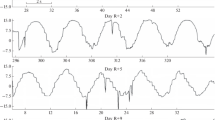Abstract.
Single-case, longitudinal studies of the three-dimensional vestibulo-ocular response (VOR) were conducted with two spaceflight subjects over a 180-day mission. For reference, a control study was performed in the laboratory with 13 healthy volunteers. Horizontal, vertical and torsional VOR was measured during active yaw, pitch and roll oscillations of the head, performed during visual fixation of real and imaginary targets. The control group was tested in the head-upright position, and in the gravity-neutral, onside and supine positions. Binocular eye movements were recorded throughout using video-oculography, yielding eye position in Fick co-ordinates. Eye velocity was calculated using quaternion algebra. Head angular velocities were measured by a head-mounted rate sensor. Eye/head velocity gain and phase were evaluated for the horizontal, vertical and torsional VOR. The inclination of Listing's plane was also calculated for each test session. Control group gain for horizontal and vertical VOR was distributed closely around unity during real-target fixation, and reduced by 30–50% during imaginary-target trials. Phase was near zero throughout. During head pitch in the onside position, vertical VOR gain did not change significantly. Analysis of up/down asymmetry indicated that vertical VOR gain for downward head movement was significantly higher than for upward head movement. Average torsional VOR gain with real-target fixation was significantly higher than with imaginary-target fixation. No difference in phase was found. In contrast to vertical VOR gain, torsional VOR gain was significantly lower in the gravity-neutral supine position. Spaceflight subjects showed no notable modification of horizontal or vertical VOR gain or phase during real-target fixation over the course of the mission. However, the up/down asymmetry of vertical VOR gain was inverted in microgravity. Torsional VOR gain was clearly reduced in microgravity, with some recovery in the later phase. After landing, there was a dip in gain during the first 24 h, with subsequent recovery to near baseline over the 13-day period tested. Listing's plane appeared to remain stable throughout the mission. The findings reflect various functions of the otolith responses. The reduced torsional VOR gain in microgravity is attributed to the absence of the gravity-dependent, dynamic stimulation to the otoliths (primarily utricles). On the other hand, the reversal of vertical VOR up/down gain asymmetry in microgravity is attributed to the offloading of the constant 1-g bias (primarily to the saccules) on Earth. The observed increase in torsional VOR gain from the 1st to the 6th month in microgravity demonstrates the existence of longer-term adaptive processes than have previously been considered. Likely factors are the adaptive reweighting of neck-proprioceptive afferents and/or enhancement of efference copy.
Similar content being viewed by others
Author information
Authors and Affiliations
Additional information
Electronic Publication
Rights and permissions
About this article
Cite this article
Clarke, A., Grigull, J., Mueller, R. et al. The three-dimensional vestibulo-ocular reflex during prolonged microgravity. Exp Brain Res 134, 322–334 (2000). https://doi.org/10.1007/s002210000476
Received:
Accepted:
Published:
Issue Date:
DOI: https://doi.org/10.1007/s002210000476




